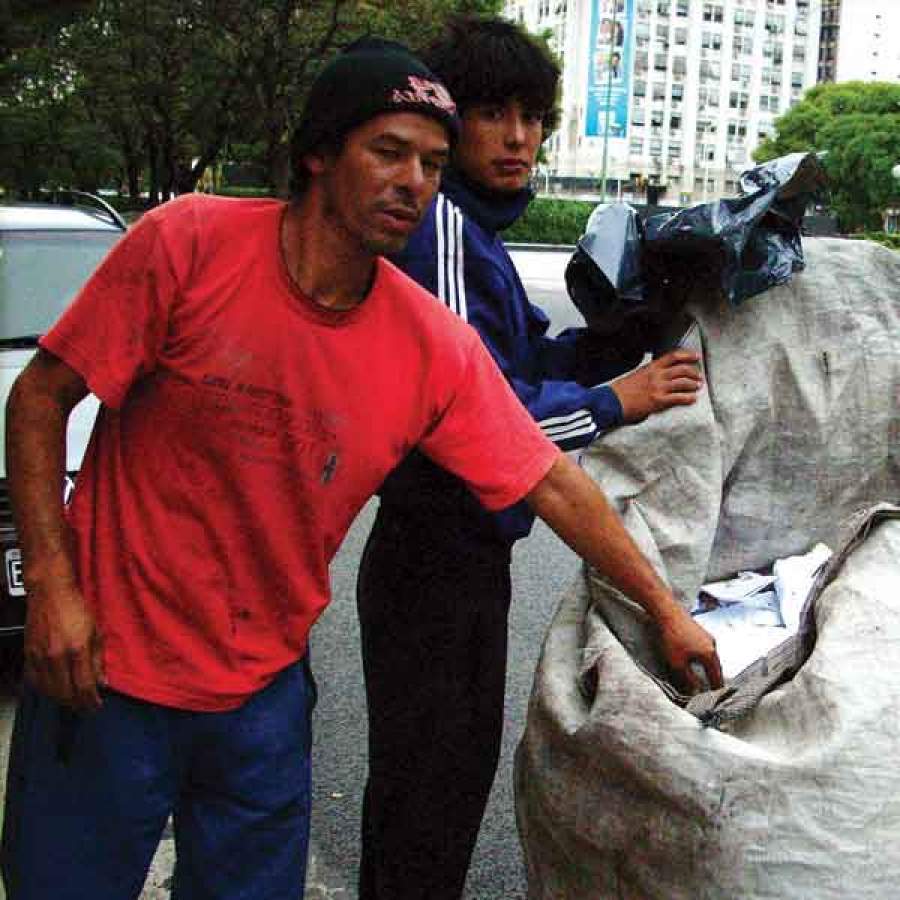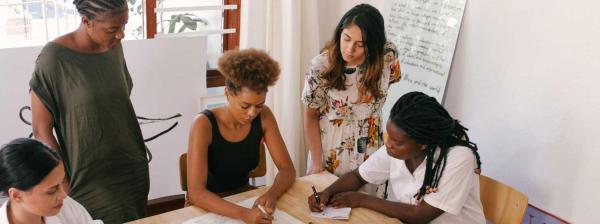Every night, an army invades the glittering avenues of Buenos Aires. They arrive in late afternoon, each armed with a trolley framing a huge, woven plastic bag. Their numbers are unknown, but estimates range from 8,000 to 40,000. They get to work quickly, opening the garbage bags put out by homeowners and shopkeepers and fishing out cardboard, plastic bottles, clothing, paper, metal—anything that can be reused or recycled. Adults and children work together all night, rushing up and down the streets until their bags are bulging with recyclables. Then, they ride a stripped-down train, the Tren Blanco, or walk dozens of blocks back to their homes in the shantytowns and poor neighbourhoods. They are the cartoneros.
Many large Latin American cities have cartoneros, named after cartón, the Spanish word for cardboard. They are the poorest residents, often non-documented immigrants, with no way to survive other than from the pittance they're paid by recycling plants or middlemen. In Buenos Aires, the cartoneros have received more attention than usual because they've become a barometer of Argentina's financial crises. When markets crashed in 2001, the numbers swelled as thousands of newly unemployed workers lost their stable lives and joined the ranks of the cartoneros.
The impact of this downward spiral is enormous. For example, many children who work overnight with their parents perform poorly in school.
I meet a father and son team beside the busy Avenida 9 de Julio early one Sunday evening. The father tells me they live fifty blocks away. I have to jog to keep up with him while he runs ahead and locates the recyclables. By the time his 14-year-old son rolls up with the cart, he has the cardboard flattened and ready for loading. Rather than riding the train, they spend an hour walking here and another hour walking back, getting home around 2 a.m.
Things have improved since the 1990s when collection was illegal and had to be carried out late at night, with the risk of police harassment. Now tourists can see the workers in touristy and well-off neighbourhoods as soon as the garbage goes out.
Adults and children work together all night, rushing up and down the streets until their bags are bulging with recyclables.
A number of community organizations, like Voluntario Global, work in the ring of shantytowns or villas from which the cartoneros emerge. Armin Diaz, a co-founder of Voluntario Global, grew up in Villa Soldati, southeast of downtown Buenos Aires. In their office, he tells me that 20 to 30 percent of Soldati residents work as cartoneros. They walk to commercial areas near the villa and spend anywhere from three to eight hours filling their trolleys, returning to sort the recyclables in their homes. The next morning, they sell to a nearby factory. For their work—six or seven nights a week—they can expect to earn about 800 pesos ($300) a month.
Voluntario Global offers half-day tours of Soldati (temporarily suspended at press time*) where visitors can meet residents and see the work being done. Joined by a few backpackers, I walk along narrow streets lined with tiny box-like houses made of red brick and cement, with flat tin roofs. Between them are piles of rubble—whenever someone manages to move out, the government has the home levelled to discourage anyone from taking their place. There are signs of cartoneros: the occasional parked trolley, a couple of men pulling a large wagon full of recyclables, a rare horse and buggy.
I travel to a rich neighbourhood in Buenos Aires to visit an organization of cartoneros who are changing the face of recycling and to improving their working conditions and lives. In leafy Palermo, I find an office filled with papers and ashtrays. There's a metre-high statue of Gauchito Gil, who, I'm informed, is the patron saint of La Cooperativa El Ceibo. El Ceibo is a 40-member collective whose aim is to dignify the work of the recuperadores (their term for cartoneros) while promoting environmentally-sustainable practices.
Maria Julia Navarro tells me the members came together in 1989 while suffering through an economic downturn. Navarro was homeless for ten years, living under a bridge while cleaning houses by day and working as a cartonero by night. She met Cristina Lezcano, now El Ceibo's president, who was part of the community of okupas (squatters) living in houses whose original residents had been evicted to make way for a proposed highway. In fact, the office where we're sitting is in a casa tomada (taken house).
Navarro was homeless for ten years, living under a bridge while cleaning houses by day and working as a cartonero by night.
In those days, the women, many of whom were single mothers, struggled to feed their children and organized to stay in their squats. Lezcano supported many women in the area, helping them get birth control pills and advocating for those in abusive relationships. As many of them became cartoneros to survive, their thoughts turned to how they could make the work safer and more dignified. They began approaching families living in this relatively well-off neighbourhood and asking them to separate their wet and dry garbage. Then, during daylight hours they could go door-to-door and pick up the dry items, which they sorted and sold for recycling. The residents have been supportive and, at last, the recuperadores are free from the stigma of going through garbage on the street.
Cristina arrives now—a small wiry woman in perpetual motion. She's shouting into her cellphone, in Spanish, "Niko, the truck is coming in 15 minutes!" When it arrives, we pile in and head for the sorting plant. On the way Lezcano tells me, "Doctors work with their hands. Recuperadores also work with their hands."
We reach a massive warehouse containing hundreds of garbage bags, but the odor is surprisingly benign. Workers stand, waist deep in the chaos, sorting it. Along the wall, I see a row of buggies used to collect this clean, dry garbage from homes in Palermo. There are colourful giant blocks made up of hundreds of soft drink bottles bundled together. And there's cardboard to spare: I watch a couple of workers stack flattened boxes in a bright blue machine as tall as a house. When they turn it on, the machine compresses the cardboard into a giant bundle.
Jorge Perez, a dignified older man from Villa #31 (a poor neighbourhood next to an affluent area called Retiro), tells me in Spanish that they sometimes find useful items like clothing, watches and perfume, "but no money." He rides his bicycle here every morning at 4:45. "The work is relaxing—I like it."
"Doctors work with their hands. Recuperadores also work with their hands."
A visitor from another co-op wears a uniform with MTE written on the back. This stands for the Movimiento de Trabajadores Excluidos (the Movement for Excluded Workers), an advocacy group for cartoneros. The motto underneath translates as "Enough of the country with two systems!" MTE has organized various demonstrations and has expressed opposition to government plans to regulate cartoneros.
Also visiting the warehouse is Guillermo De Luca, an official with the recycling department of the city government. De Luca is part of those plans and proud of them. "We want to make the work more dignified for the cartoneros so they won't have to go through people's garbage," he explains on the ride back to Palermo. The government is also concerned about the mess that some cartoneros leave on the street after sorting the garbage, a practice that heightens tensions with city residents. To address this concern, the government wants to follow El Ceibo's model of door-to-door collection, first with businesses and eventually with homes.
Cartoneros are encouraged to join co-operatives and register with the authorities—those who do are issued work gloves and reflectors in return. Cartoneros who do not belong to co-ops, (currently the majority, according to some sources) will be encouraged to work at sorting centres like the one we just visited. It's part of the city's Basura Cero (Zero Waste) plan to reduce the amount of garbage going to landfills 75 percent by 2017. De Luca announces, "I'm a dreamer but I'm not the only one, like John Lennon says."
However there may be an underside to this dream. There are concerns among the MTE that the government wants to drastically reduce the number of cartoneros to only those who are registered, excluding the rest.
I can see how this could weigh heavily on the numerous cartoneros without legal immigration status, who might be permanently relegated to the underground. De Luca assures me they can still register but says Cartoneros who don't register won't have the same rights to collect garbage in the streets.
There are concerns among the MTE that the government wants to drastically reduce the number of cartoneros to only those who are registered, excluding the rest.
The best-off cartoneros may be those who sell to Eloísa Cartonera, a book publishing co-operative and arts centre that pays top dollar for clean, strong cardboard they can use for their covers. As member Juan Guillermo Gómez explains to me when I visit, most places pay 7 centavos ($0.02) per kilo but they pay 1.50 pesos ($0.57).
We're in a dimly lit workshop, which doubles as their storefront retail space, in La Boca. The wall, covered in books, looks like a children's quilt. Most covers are bare brown corrugated cardboard with the titles painted in bright tempera—some incorporate designs from the original cardboard.
Gomez tells me they publish contemporary Latin American literature, especially new and lesser-known authors. A few famous writers like Ricardo Piglia donate rights, allowing them to publish their work, which sells at low prices. They have over 130 titles that they sell at book fairs and stores throughout Argentina and around the world. Some are translated into English, Portuguese and German. At their own store, books cost only 5 to 30 pesos ($2 to $11). They work with the cartoneros they trust, letting them know when they need new supplies about every two weeks.
Another member, Miriam, moves outside to a table on the sidewalk where she paints covers. She was a cartonero, she tells me. She makes a stencil of the book title, then places the stencil over the cover and slaps on a layer of white paint. Later, colourful letters will be applied over the white.
Back in Palermo, I meet a young cartonero who asks me for money to buy soap. He agrees to pose for a photo but asks nervously if it will be published in Argentina. He tells me that tonight he will spend a total of two hours travelling and three hours collecting recyclables.
A young woman I meet on tony Malabia Street, declines a photo "because I'm working." She works with her parents and together they make about 300 pesos ($114) a week. The travel is long (one-and-a-half hours each way) but she doesn't find the work dangerous because they don't stay out late. The local people are helpful, she says.
It's 4 a.m. when I encounter my last cartonero, running down the Avenida 9 de Julio, which is not deserted even at this hour. He's rushing to catch the Tren Blanco for his two- hour ride home.
"I'll make 50 pesos ($19) for this load," he says, cheerfully, pointing at his nearly-full cart. "I found some new clothes I can sell." And with that, off he sprints into the night.
*In recent months, tensions have developed in Villa Soldari after community members were relocated by the Buenos Aires city government.
La Cooperative El Ceibo and Eloisa Caronera are open to working with volunteers. For more information on volunteering in La Boca, and other opportunities in Argentina, click here.
More Destination Argentina:
Volunteer, Work and Study Opportunities
Backgrounder: Argentina
A Glimpse of the Gaucho Fair
Regional Highlights





